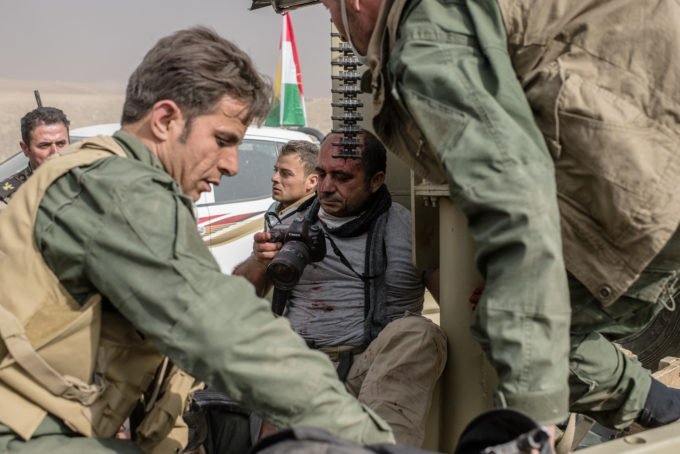
R&K Insider: In honor of journalists who risk their lives

As we mark World Press Freedom Day this week, let’s pause and remember the risks journalists face around the world.
This post originally appeared on May 4, 2018, in R&K’s weekly newsletter. Read the archives and subscribe to the newsletter.
It usually starts with a text message, and then a series of missed calls.
Are you OK?
Do you know where Beth is?
Have you heard from Steve?
Then a frantic rush to find out what happened—checking in with your friends, calling their partners, parents, fixers, anyone who might know where they are. It occurs in the middle of a dinner in Chicago, a dive bar on the Syrian border, while riding through the Iraqi desert, during a family vacation, or in the middle of the night. There’s no amount of planning you can do to prepare for these messages.
But then, no one really prepares for a suicide bomb or a shooting at the mall either. There’s no way tell when an Israeli sniper is going to kill a freelance photographer, or when a despotic regime is going to detain a reporter. There’s no way to prepare for a landmine in Mosul that takes out a group of reporters. The texts and calls pour in all the same as nervous voices and fingers—colleagues, friends, family—keep tapping on the other end of the line.
These incidents happen frequently, but it reached a peak this past month. First with the death of 30-year-old Yaser Murtaja, shot by an Israeli sniper while covering protests in Gaza. Then earlier this week in Kabul, as a group of journalists rushed to cover the scene of a bomb, a suicide bomber blew himself up, taking the lives of 25 people, including nine journalists. It was the single deadliest attack on the press since the massacre of 18 journalists in the Philippines in 2009.
Among those killed in Kabul this week was Shah Marai, the chief photographer for Agence France-Presse in Kabul. He left behind six children and a wife (our colleagues have set up a fund for them here). “He loved the camaraderie of being part of the press because he had to work so hard to get there. I’ll miss him always,” said Karishma Vyas, a documentary journalist who worked alongside Marai in Afghanistan.
Having worked for AFP in Afghanistan for over two decades, Marai knew the risks that came with his work. “Every morning as I go to the office and every evening when I return home, all I think of are cars that can be booby-trapped, or of suicide bombers coming out of a crowd. I can’t take the risk,” he wrote in a blog post two years ago. Even then, he was out each day, doing the best work, documenting life and loss in his hometown with dignity.
As we mark World Press Freedom Day this week, I can’t help but urge that we pause and remember the risks journalists face around the world. Hundreds of journalists are imprisoned in Turkey, dozens have been targeted, kidnapped, and killed by ISIS, and thousands of others face threats for just for doing their job.
I spent the past two years covering the war against ISIS in Iraq. The photo at the top of this newsletter is of my colleague, Younes Mohammad, just after he was injured in a mortar blast as the Peshmerga forces advanced on ISIS fighters in the fall of 2016. We were heading towards the frontline as Younes rolled passed us in the opposite direction on this pickup truck—shrapnel wounds to his head, the body of a dead Kurdish fighter at his feet. I saw him pick up his camera and take a photo as tears and blood ran down his face. He nearly died that day.
As a photographer, and now the photo editor at Roads & Kingdoms, I care deeply about the well-being of our colleagues in the field. One of the things I’ve admired about R&K is the interview series with photographers, highlighting unique projects by those lesser known, yet passionate about the profession.
We’ve revived the photographer Q&A this week with an interview with a talented young photographer from my hometown of Chicago: Sebastian Hidalgo. At just 22, Hidalgo has put a lot of time and thought into what happens when your neighborhood starts changing and what it does to your community. We hope you read this interview and share his work.
We’ve also published a story on how Istanbul’s Ottoman-era mansions are being occupied by the city’s newest tenants: Syrian refugees. And hot off the (internet) press this morning, check out this photo essay by Cate Dingley, who visited the remains of the “Human Zoo” outside Paris and matched them with historical photographs from a local French museum.
Over at R&K sister-site Explore Parts Unknown, our colleagues have published a deep dive into Uruguay, the land of progressive reforms, yerba mate, and meat—lots and lots of meat. Check back next week for more stories from a new city in a new country.
If you love photojournalism and have been following R&K’s photo-driven stories by reporters around the world, I’d love to hear from you. Let me know what you’d like to see more of and what we can do better. I’m at cengiz@roadsandkingdoms.com
Have a great weekend. Anup will be back next week.
— Cengiz
Sign up for R&K Insider, our collection of the most compelling happenings in food, politics, and travel from across the web.